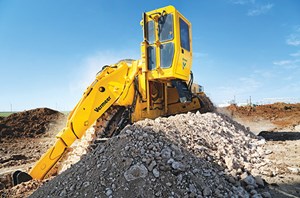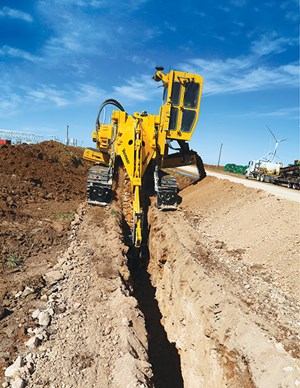May 2023 Vol. 78 No. 5
Features
Choosing the right trencher: Benefits, configurations, performance optimization
By Maggie Moller
(UI) — Many contractors use excavators to handle the bulk of trenching work because they already have them in their fleet. However, excavators aren’t always the optimal machine for the job, especially in challenging ground like rock and hard clay.
Excavators and track trenchers are both designed to cut through and remove rocks or soil from the ground. But an excavator has to set up, dip, pull, swing, dump and repeat to do the job, and those repeated cycles take time. A trencher can remove the same rocks and soil in one continuous movement. In fact, in many scenarios and ground conditions, a trencher can work three to four times faster than an excavator.
But some contractors continue to employ excavators instead of track trenchers simply because they have always done it that way. According to Vermeer Application Specialist Gregg Van Roekel, frequently, contractors do not consider a trencher simply due to unfamiliarity. “If they take a step back and think through the process of digging a ditch from Point A to Point B, the benefits of using a trencher are clear.”
Optimal digging
A trencher will leave the ditch clean with straight sidewalls and a flat, on-grade bottom. But digging with an excavator often will result in the need for more bedding on the bottom. Uneven walls and inconsistent depths are also more likely to resist compaction and may increase surface patching costs.
Also, excavators struggle digging in rock. That means a contractor has to bring in a hammer attachment to break up the ground. The large chunks of material excavated are usually not suitable to be used as backfill, either. Additional backfill often must be hauled in, adding to the time and cost of a job.
Conversely, trenchers can efficiently cut rock of approximately 20,000 pounds per square inch and less. The spoils from the trench are small, stackable materials that can be used as backfill, depending on the engineering specifications for the project.
Spec’ing a trencher
“Another concern that some contractors have about using trenchers is related to sizing a machine and making sure it is configured correctly for a project,” said Barry Scieszinski, Vermeer application specialist.
“Choosing the right unit typically starts by analyzing the type of material the machine will be working in. Smaller, lower-horsepower machines are more effective with soil trenching, but as the relative hardness of the material increases, so do the demands on the machine.”
According to Van Roekel, crews can usually get by with a smaller trencher in soft or loose rock formations. However, harder rock formations require more horsepower.
“Using a small trencher in solid rock will take more time, and crews will go through more teeth in the process. Similarly, choosing a large trencher for digging in softer rocks will not increase production rates and can limit how narrow a trench crews may be able to dig,” he said.
Trencher teeth
To get the most performance from these powerful machines, there are a few critical steps Van Roekel and Scieszinski recommend, from their work with hundreds of contractors in the field.
“First, the contractor should be aware that different-sized trenchers take different-sized teeth,” said Scieszinski. “The tooth shank for small- to mid-sized trenchers typically measures about 1 inch in diameter from the base of the tooth to the retainer. And larger trenchers require the 1½-inch tooth shank to support the higher horsepower of those powerful trenchers.”
Next, it’s important to select the appropriate style of tooth for the ground conditions.
“The tip of a trencher’s tooth can range from rounded, dull surfaces to pointed, spiked styles,” said Van Roekel. “The rounded-face teeth, with a larger carbide surface, can hold up longer than more aggressive, smaller, carbide-tipped teeth. The teeth with a larger surface area are effective at breaking up softer rock formations like sandstone and limestone.
“For harder rocks, contractors should employ a more aggressive tooth style for deeper rock penetration.”
Once the tooth style has been chosen, it will be necessary to select a tooth pattern.
Trencher chains usually come with a standard V digging pattern, and the number of chevrons varies by the boom length and chain width. On wider chains, a chevron may start with a single center tooth and build to as many as three teeth on the outer plates. Each tooth bites off between 2 and 4 inches of material, depending on the rock’s density.
“Crews working in very hard rock may want to consider using a staggered pattern that incorporates short and long teeth,” Scieszinski explained. “For this pattern, longer teeth are placed in the middle of the chevron to make the initial impact, and then shorter teeth are used at the outer edges to pull the chips out of the way.
“Using a combination of smaller carbide-tipped teeth and larger-surfaced carbide teeth is also another combination often employed. This configuration mimics the way people chew their food. Teeth in the middle cut and the outer teeth grind and reduce the particle size.”
Buying versus renting
Once a contractor determines which trencher is right for the project at-hand and selects the proper configuration, the next decision is more financial or budgetary.
If intended to be operated on a consistent basis, especially when the contractor owns, operates and maintains a larger fleet of equipment, outright ownership is most likely the best fit.
Another factor is whether the trencher will be used frequently in the same ground conditions. If so, the contractor, regardless of size, should consider buying.
On the other hand, renting from the dealer may be a practical strategy if the company uses the trencher more sporadically or are usually working in different ground conditions. These trenchers are highly specialized, so a dealer may be the only source for rental.






Comments